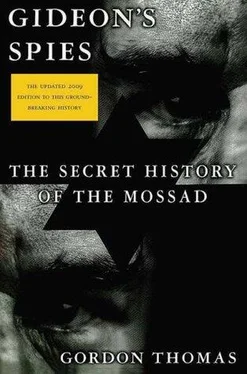Gordon Thomas - Gideon's Spies
Здесь есть возможность читать онлайн «Gordon Thomas - Gideon's Spies» весь текст электронной книги совершенно бесплатно (целиком полную версию без сокращений). В некоторых случаях можно слушать аудио, скачать через торрент в формате fb2 и присутствует краткое содержание. Город: New York, Год выпуска: 2009, ISBN: 2009, Издательство: Thomas Dunne Books, Жанр: История, на английском языке. Описание произведения, (предисловие) а так же отзывы посетителей доступны на портале библиотеки ЛибКат.
- Название:Gideon's Spies
- Автор:
- Издательство:Thomas Dunne Books
- Жанр:
- Год:2009
- Город:New York
- ISBN:978-0-312-53901-6
- Рейтинг книги:4 / 5. Голосов: 1
-
Избранное:Добавить в избранное
- Отзывы:
-
Ваша оценка:
- 80
- 1
- 2
- 3
- 4
- 5
Gideon's Spies: краткое содержание, описание и аннотация
Предлагаем к чтению аннотацию, описание, краткое содержание или предисловие (зависит от того, что написал сам автор книги «Gideon's Spies»). Если вы не нашли необходимую информацию о книге — напишите в комментариях, мы постараемся отыскать её.
Gideon’s Spies
Gideon's Spies — читать онлайн бесплатно полную книгу (весь текст) целиком
Ниже представлен текст книги, разбитый по страницам. Система сохранения места последней прочитанной страницы, позволяет с удобством читать онлайн бесплатно книгу «Gideon's Spies», без необходимости каждый раз заново искать на чём Вы остановились. Поставьте закладку, и сможете в любой момент перейти на страницу, на которой закончили чтение.
Интервал:
Закладка:
The Mossad chief knew exactly the right tone to strike with one of the grandees of the intelligence world, commanding a staff of 2,000—of whom 175 were field intelligence officers, spies. Dearlove had a salary of £150,000 a year, many times greater than Dagan earned. The head of MI6 also had enviable perks: a car with an armed driver, and membership to several exclusive London clubs.
Dagan did not begrudge him any of this. He knew Dearlove had earned his perks.
After graduating from Cambridge, Dearlove joined MI6 in 1964. Four years later he was working undercover in Nairobi. From the Kenyan capital he often traveled to South Africa, making contacts with BOSS, then the South African security service. In 1973 he was posted to Prague as deputy head of the MI6 station. In that position he ran an operation to penetrate the Warsaw Pact. Under his guidance several senior pact spies defected to the West.
After a stint in Paris he was posted to Geneva, his cover was that he was a diplomat attached to the United Nations. There he made his first serious contacts with Arab intelligence officers from Iraq, Syria, and Iran.
A year later he turned up in Washington as a senior liaison officer for MI6 with the U.S. intelligence community. In the spring of 1992 he was back in London, charged with the task of supervising MI6’s move from its crumbling headquarters in Century House in the rundown suburb of Lambeth to its postmodern £236 million structure in Vauxhall Cross. It is said that by the time the building was opened, Dearlove had personally checked out every room, tested the menus in the canteen, and slept in the beds in the basement dormitory used by staff during a crisis.
His trips to Washington were frequent. He had astonished his counterpart at the CIA, George Tenet, by making it clear that he no longer saw the hunt for Osama bin Laden as a top priority for MI6. Privately Dearlove had been heard to say that “capturing bin Laden, dead or alive, is very much Bush seeking a headline.”
Dagan had warmed to Dearlove when the latter said he was no devotee of the American faith in “Sigint”—satellite signals intelligence. He believed spies on the ground were more valuable and trustworthy, that with human intelligence “you get what they see at close up, not from outer space.” In a world of encrypted e-mail messages and superenhanced satellite imagery, Dagan found something endearing in that judgment. It mirrored his own views.
Dagan looked forward to his meeting with Eliza Manningham-Buller more than with any other spy chief. The director of MI5 was only the second woman to head the service. With her double chin and a booming laugh, which seemed to come from somewhere in her ample bosom, she was a striking figure.
At fifty-three, four years younger than Dagan, she also earned a salary far greater than he could ever hope to command; indeed, she earned more than her ultimate political master, Prime Minister Tony Blair.
Her crystal-shattering voice went with her upper-class pedigree. She was the daughter of a former lord chancellor of England; one of her two sisters was married to a former deputy keeper of the privy purse to the Queen.
She had attended Oxford, where she’d been known as “Bullying Manner” for her intimidating ways. In 1968, the university’s Dramatic Society pantomime program for Cinderella listed “The Honourable Eliza Manningham-Buller” as the Fairy Godmother. Wearing a headdress of flowers and with her bushy eyebrows trimmed, she came onstage in a puff of smoke. She twirled and, to a startled Cinderella—and audience—she boomed: “We thought you would be surprised. But have no fear. I am your Fairy Godmother, my dear.”
That night an MI5 recruiter—an Oxford don—suggested that Eliza should give up any plans to take up acting and join MI5. She listened carefully, then consulted her father. He said spying was no career for a lady.
Eliza promptly joined MI5 as a transcription typist of tapped telephone conversations, mostly those of Soviet Bloc diplomats in London. But soon she displayed a talent for making sense of their guarded talk. She became a counterintelligence officer—a spy catcher.
“Bullying Manner” became “Formidable Manner.” She rose rapidly through the structured MI5 hierarchy.
Taller than most of her colleagues, she had an imperious way of looking down her Roman empress nose when someone annoyed her. Rebuke delivered, she strode off down one of the cheerless corridors of MI5 “like a man o’war in full sail,” one colleague said. She had worked in Washington, and in those other postings where the streets have no names. She headed the MI5 team that investigated the Lockerbie disaster and spearheaded MI5’s undercover war against the IRA.
In 1997 she became deputy director general of the service. Three years later, she ran MI5.
For both his hosts, Meir Dagan had the same uncompromising message: London had become a paradise for terrorists, a city that allowed a terrorist to live in a democracy and be able to destroy what the word meant. Because their prime target was still Israel, this had to stop. Dagan said it politely. But he said it firmly.
He understood, he added, the difficulty Britain faced. It was home to 1.8 million Muslims, the great majority of whom were law-abiding, peaceful citizens. He knew Britain had strong trading ties with Arab nations. But he also understood that extreme Islamic groups had been able to operate deep within the closed Muslim community of Britain. He was ready to put Mossad at the disposal of MI5 and MI6. For that to work he would require permission to increase the number of his agents operating in Britain. Since 1987 the number had been curtailed, after the Thatcher government had complained about Mossad’s methods.
Both Dearlove and Manningham-Buller swiftly agreed. Within days, the Mossad agents arrived in London. With them they brought a list of Muslim radicals they feared were preparing to strike at Israeli targets. The Mossad team made it clear that they would operate on their own. And they would deal with any threat to Israel as forcefully as they always had. They could make an assassination look like an accident—or let it serve as a warning to others by not bothering to hide what they had done.
And now, in January 2003, it was an assassination that Meir Dagan knew also preoccupied President George W. Bush and his aides. It was how best to kill Saddam Hussein.
As the drumbeat of impending war with Iraq beat ever louder in Washington, President George W. Bush let it be known to his closest advisers that he was prepared to lift the ban on the CIA assassinating Saddam Hussein. The restraint on the agency killing any leader had been in force since the CIA’s inglorious bungling of its attempts to murder Cuba’s leader, Fidel Castro, in the 1970s. The Executive Order was never officially waived, but on the first days of the new year, in the seasonal cold weather of the American capital, the neoconservatives who surrounded the president—men and women who for the most part had advised Bush’s father when he had been president—exchanged toasts that Saddam could soon be dead.
Secretary of Defense Donald Rumsfeld argued that the United States had the legal right to assassinate anyone who had been involved “either directly or planning” the September 11 attacks. Saddam had, Rumsfeld claimed, “another strike” against him because he was stockpiling weapons of mass destruction (WMD). Though Secretary of State Colin Powell and CIA director George Tenet and his analysts insisted there was no firm evidence that Saddam was linked to the September attacks or that he had WMDs, Rumsfeld insisted his own sources told a different story.
Mossad’s resident katsa at the Israeli embassy in Washington had discovered that Rumsfeld’s main source was Ahmad Chalabi, who had helped to found the Iraqi National Congress, the self-styled “Iraqi government in waiting” to replace a deposed Saddam.
Читать дальшеИнтервал:
Закладка:
Похожие книги на «Gideon's Spies»
Представляем Вашему вниманию похожие книги на «Gideon's Spies» списком для выбора. Мы отобрали схожую по названию и смыслу литературу в надежде предоставить читателям больше вариантов отыскать новые, интересные, ещё непрочитанные произведения.
Обсуждение, отзывы о книге «Gideon's Spies» и просто собственные мнения читателей. Оставьте ваши комментарии, напишите, что Вы думаете о произведении, его смысле или главных героях. Укажите что конкретно понравилось, а что нет, и почему Вы так считаете.












